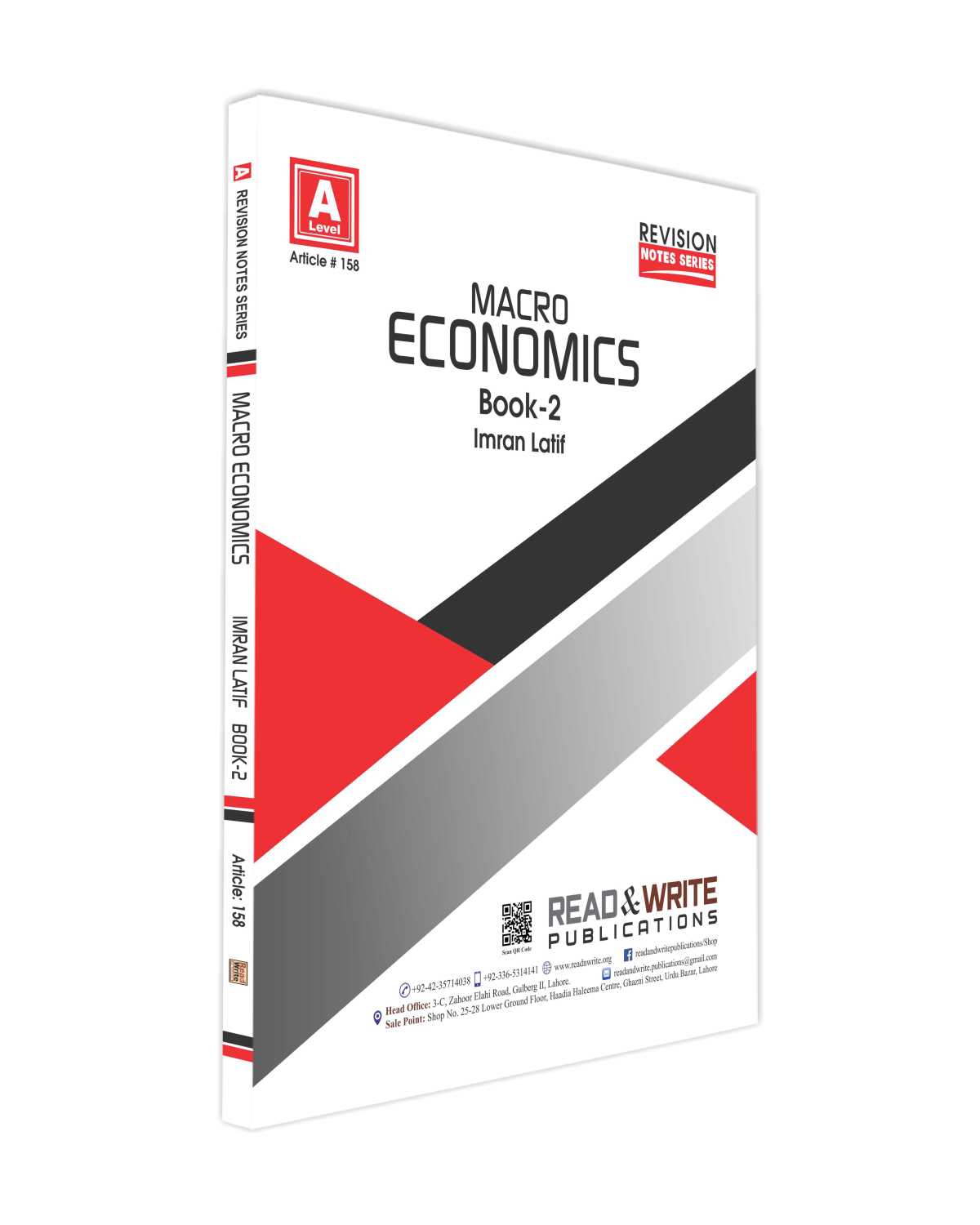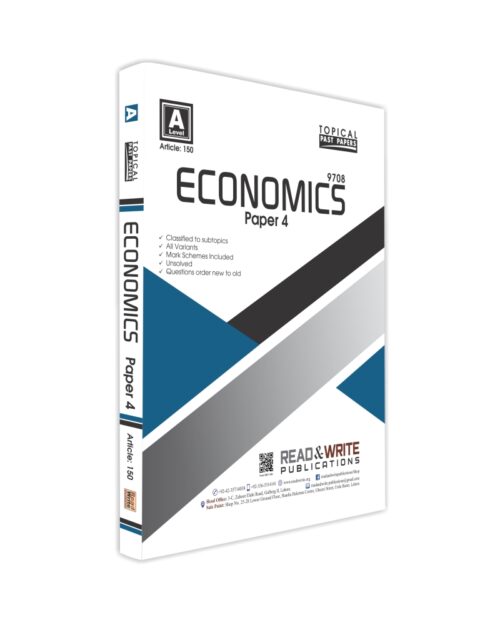| Book Code : | 158 |
|---|---|
| Subject Code : | 9708 |
| Author : | Imran Latif |
| Language : | English |
| Publishers : | Read and Write Publications |
Description
158 Micro Economics Book 2 AS Level Notes
The idea of writing notes for Cambridge A-level Micro Economics Notes came to me in 2003, when, having already taught for a year, I realized that no single economics book available in the local and international markets covered all the topics with the depth and perspective required by the CIE syllabus.
Both students and teachers had to consult 3 to 4 different books to find all the material that they needed—private candidates and 00 teachers had it even worse. Furthermore, it was really difficult for students to keep having to refer through different books when the exams were close and they were starved for time.
I took on the challenge and decided to write a comprehensive text that explicitly followed the syllabus and exam pattern of the CIE.
Micro Economics Notes
A year and a half later, in the middle of 2004, I had finally written and published four entire volumes of A level economics notes. Part of them had been hand-written, and part of them had been typed. Soon, word of their usefulness spread, and they were bought all over Pakistan.
The notes had served their purpose well till the end of 2014. Till that point, there had only been minor changes in the syllabus. But now, there was a dire need to update them, for the new syllabus for the 2019 examination introduced some significant changes in course content.
In this new and improved edition, old topics have been revised and new topics have been added. At the end of each topic there is a relevant list of essay questions spanning from 1990 to 2019.
These questions provide a clear guideline regarding how the examiners assess students’ knowledge on the topics for Paper 2 and Paper 4, allowing the student to practice effectively.
While writing these notes I kept in mind the way in which the examiner tests MCQs as well. The notes have been divided into four volumes to make it easier for those who are following the AS and A2 track separately and for those who are taking the composite exam; the syllabus division in the following pages has been provided for this express purpose. I hope my efforts will help to contribute both to the learning of the student, as well as to the inquisitiveness of any teachers of A-level economics. Your suggestions will help me improve the quality of the content for later editions and will be highly appreciated.
Following Topics are covered in this book
Micro Economics Notes
TABLE OF CONTENTS
UNIT 1 AGGREGATE DEMAND (AD) AND AGGREGATE SUPPLY (AS)
CONCEPTS OF NATIONAL INCOME
SECTORS AND TYPES OF ECONOMIES:
AGGREGATE DEMAND (AD):
Why does the AD curve slope downward?
Changes in Aggregate Demand
AGGREGATE SUPPLY (AS)
The short-run aggregate supply curve
The shape of the long-run aggregate supply curve
INTERACTION OF AGGREGATE DEMAND AND AGGREGATE SUPPLY AND NATIONAL INCOME EQUILIBRIUM
CHANGES IN NATIONAL INCOME EQUILIBRIUM
BUSINESS (TRADE) CYCLE
UNIT 2 MONEY AND INFLATION
MONEY
History of specialization, trade, and money
Concepts
Features of money
Functions of money:
INFLATION
MEASUREMENT OF INFLATION / VALUE OF MONEY / COST OF LIVING
THE CAUSES OF INFLATION
Demand-pull Inflation
Cost-push Inflation
THE CONSEQUENCES OF INFLATION
Costs:
Benefits
CAUSES AND CONSEQUENCES OF DEFLATION
PAST PAPER QUESTIONS
UNIT 3 INTERNATIONAL TRADE
DOMESTIC AND INTERNATIONAL TRADE
THEORIES OF INTERNATIONAL TRADE:
Theory of absolute advantage
Theory of Comparative advantage
Mutually beneficial rate of exchange:
Trading possibility curve (TPC):
LIMITATIONS OF ABSOLUTE AND COMPARATIVE ADVANTAGE THEORY:
PROTECTIONISM
Methods of protection and their impact
Effectiveness of protectionism:
THE ARGUMENTS IN FAVOR OF FREE TRADE AND AGAINST PROTECTIONISM
THE ARGUMENTS IN FAVOR OF PROTECTIONISM AND AGAINST FREE TRADE
TRADE BLOCS OR INTERNATIONAL ECONOMIC INTEGRATION
CONSEQUENCES OF FORMATION OF TRADING BLOCS:
1 creation (Micro Economics Notes)
2 diversion
PAST PAPERS QUESTION
4 Micro Economics Notes
UNIT 4 EXCHANGE RATE
DEFINITIONS AND MEASUREMENT OF EXCHANGE RATES
EXCHANGE RATE SYSTEMS
Free Floating Exchange Rate System
Fixed Exchange Rate System
CAUSES OF EXCHANGE RATE DEPRECIATION
CAUSES OF EXCHANGE RATE APPRECIATION
EFFECTS OF DEPRECIATION/DEVALUATION
EFFECTS OF APPRECIATION/REVALUATION
ADVANTAGES AND DISADVANTAGES OF EXCHANGE RATE SYSTEMS:
Managed floating system
THE TERMS OF TRADE
Movements in Terms of Trade
The Impact of changes in the terms of trade
PAST PAPER QUESTIONS
UNIT 5 BALANCE OF PAYMENTS
COMPONENTS OF THE BALANCE OF PAYMENTS
BALANCE OF PAYMENT DISEQUILIBRIUM
CAUSES OF BALANCE OF PAYMENT DISEQUILIBRIUM
CONSEQUENCES OF A CURRENT ACCOUNT DEFICIT AND A CURRENT ACCOUNT SURPLUS
Consequences of current account deficit:
Consequences of current account surplus:
PAST PAPER QUESTIONS
UNIT 6 GOVERNMENT INTERVENTION IN A MACRO-ECONOMY
MACROECONOMIC POLICIES:
1 policy
2 policy
3-side policy
POLICIES TO CORRECT CURRENT ACCOUNT DEFICIT
1-switching policies:
2-dampening policies:
POLICIES TO REDUCE CURRENT ACCOUNT SURPLUS:
POLICIES TO CORRECT DEMAND-PULL INFLATION
POLICIES TO CORRECT COST-PUSH INFLATION
POLICIES TO CORRECT DEFLATION AND THEIR EFFECTIVENESS
PAST PAPER QUESTIONS
You must be logged in to post a review.








Reviews
There are no reviews yet.